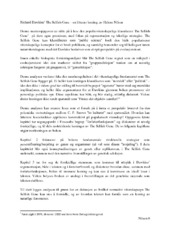Popular science - common ground. A literary critique of Richard Dawkins's The Selfish Gene
Abstract
This thesis aims to perform a literary reading of Richard Dawkins's The Selfish Gene from a perspective situated outside of the 'battle of the two cultures'. Chapter 1 takes Foucault's article What is an author?" as its point of departure. After discussing how Dawkins may be seen as a reader of Darwin, I will go on to discuss Foucault's concept of the author-function, before I move on to consider some different readings of and approaches to The Selfish Gene. With reference to a polemic between Dawkins and Mary Midgley, I will also establish Dawkins as a reader of his own book, and account for his concept of poetic science. Chapter 2, entitled The Language of Convenience and Displaced Agency in The Selfish Gene", constitutes the first part of my close reading. This chapter is concerned with what I consider to be the fundamental structural strategies of the book, such as personification, narration and the gene-definition that The Selfish Gene operates with. The latter particularly regards the relationship between genotype, an individual's set of genes, and phenotype, the genes' realization in terms of physical traits. Furthermore, I will examine the representation of the body as survival machine', both in terms of its function and its effect. In Chapter 3, Reading Nature" I extend the perspective of my close reading. The first half of this chapter addresses the multiple voices of The Selfish Gene, which I will categorize as author-function, the reflexive narrator and the meta-narrator, with particular focus on their potential to exert methodological control'. These categories are not meant to represent fixed entities, but different functions. From this starting point, I will show how the reader is addressed and situated in the text, and go on to argue that the multiple voices of the book appeal to an ideal reader'. The focus of the second half of the chapter examines the meaning potential of analogy, and discusses how this meaning potential affects the construction of a genetic rationale'
